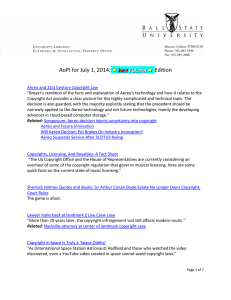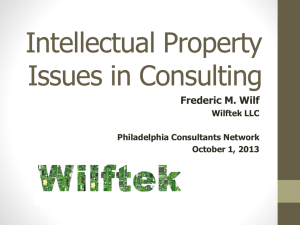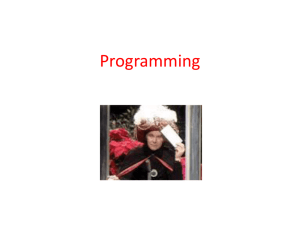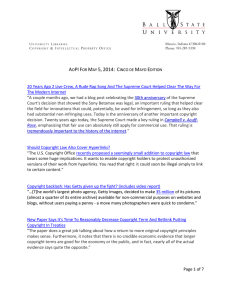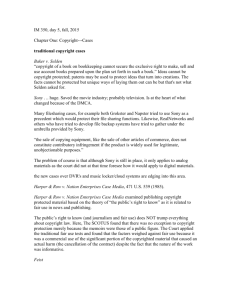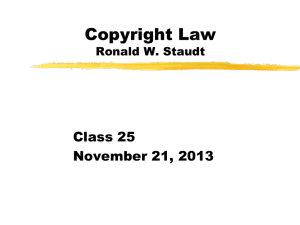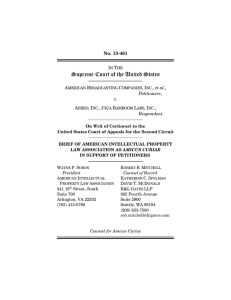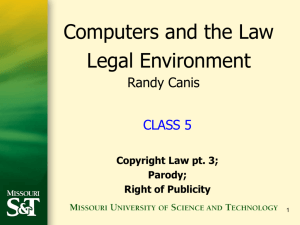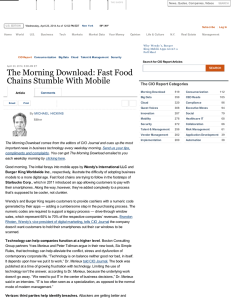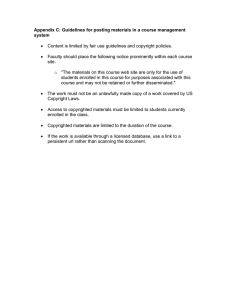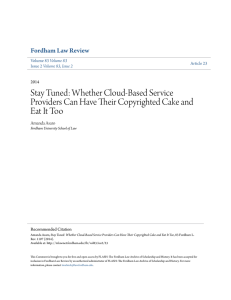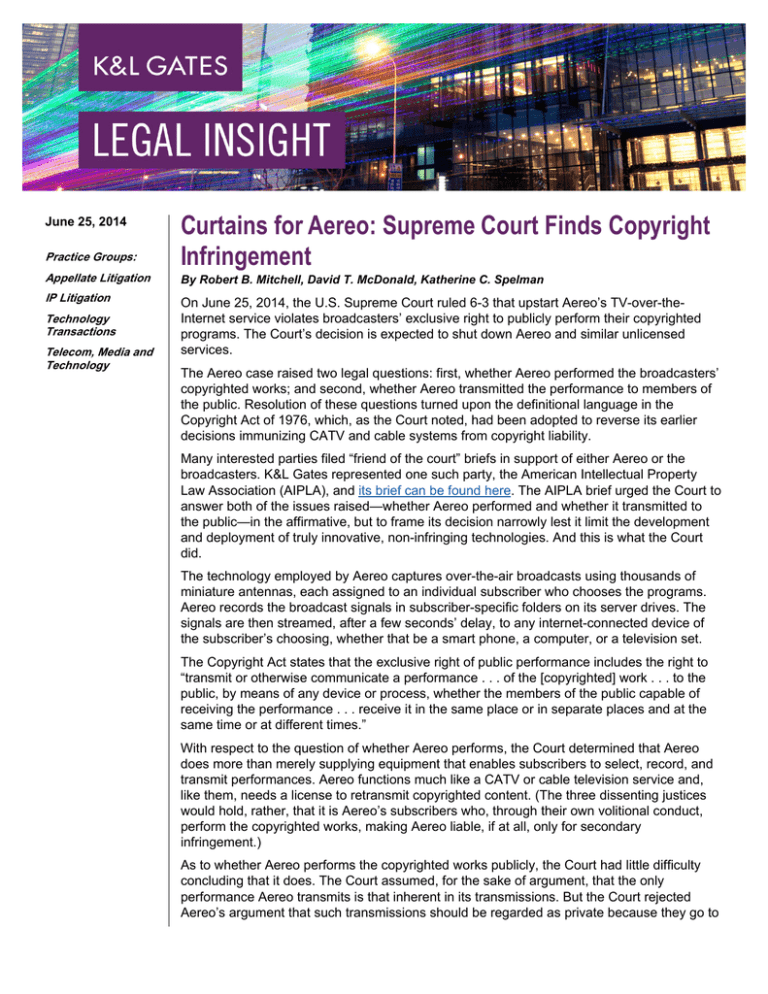
June 25, 2014
Practice Groups:
Curtains for Aereo: Supreme Court Finds Copyright
Infringement
Appellate Litigation
By Robert B. Mitchell, David T. McDonald, Katherine C. Spelman
IP Litigation
On June 25, 2014, the U.S. Supreme Court ruled 6-3 that upstart Aereo’s TV-over-theInternet service violates broadcasters’ exclusive right to publicly perform their copyrighted
programs. The Court’s decision is expected to shut down Aereo and similar unlicensed
services.
Technology
Transactions
Telecom, Media and
Technology
The Aereo case raised two legal questions: first, whether Aereo performed the broadcasters’
copyrighted works; and second, whether Aereo transmitted the performance to members of
the public. Resolution of these questions turned upon the definitional language in the
Copyright Act of 1976, which, as the Court noted, had been adopted to reverse its earlier
decisions immunizing CATV and cable systems from copyright liability.
Many interested parties filed “friend of the court” briefs in support of either Aereo or the
broadcasters. K&L Gates represented one such party, the American Intellectual Property
Law Association (AIPLA), and its brief can be found here. The AIPLA brief urged the Court to
answer both of the issues raised—whether Aereo performed and whether it transmitted to
the public—in the affirmative, but to frame its decision narrowly lest it limit the development
and deployment of truly innovative, non-infringing technologies. And this is what the Court
did.
The technology employed by Aereo captures over-the-air broadcasts using thousands of
miniature antennas, each assigned to an individual subscriber who chooses the programs.
Aereo records the broadcast signals in subscriber-specific folders on its server drives. The
signals are then streamed, after a few seconds’ delay, to any internet-connected device of
the subscriber’s choosing, whether that be a smart phone, a computer, or a television set.
The Copyright Act states that the exclusive right of public performance includes the right to
“transmit or otherwise communicate a performance . . . of the [copyrighted] work . . . to the
public, by means of any device or process, whether the members of the public capable of
receiving the performance . . . receive it in the same place or in separate places and at the
same time or at different times.”
With respect to the question of whether Aereo performs, the Court determined that Aereo
does more than merely supplying equipment that enables subscribers to select, record, and
transmit performances. Aereo functions much like a CATV or cable television service and,
like them, needs a license to retransmit copyrighted content. (The three dissenting justices
would hold, rather, that it is Aereo’s subscribers who, through their own volitional conduct,
perform the copyrighted works, making Aereo liable, if at all, only for secondary
infringement.)
As to whether Aereo performs the copyrighted works publicly, the Court had little difficulty
concluding that it does. The Court assumed, for the sake of argument, that the only
performance Aereo transmits is that inherent in its transmissions. But the Court rejected
Aereo’s argument that such transmissions should be regarded as private because they go to
Curtains for Aereo: Supreme Court Finds Copyright Infringement
subscribers individually. In addition to the practical similarity between Aereo’s service and
cable systems, the language of the Copyright Act encompasses multiple transmissions and
their receipt in different places and at different times. These transmissions go to the public,
because Aereo’s subscribers are a large group of people outside the normal circle of family
and friends.
The Court took pains to distinguish Aereo’s service from other cloud-based offerings. It
noted, for example, that Aereo’s subscribers do not have any prior relationship to the
copyrighted works in question; they do not receive performances of works that they own or
possess. If they did, the performances likely would not be to “the public.” The Court likened
this situation to a parking valet’s returning cars to their drivers rather than to the public.
The Court also described its holding as “limited”: The decision focuses on a system
functionally equivalent to a cable system; it addresses transmissions, not the distribution of
copies (i.e., streaming, not downloading); and it should not be read to apply where a “user of
a service pays primarily for something other than the transmission of copyrighted works,
such as the remote storage of content.”
Finally, the Court pointed out that transmissions are not public if limited to a family and its
social circle, and it cited the doctrine of fair use as a check on inappropriate or inequitable
applications of the public performance right. The Court concluded: “We cannot now answer
more precisely how the . . . Copyright Act will apply to technologies not before us.” It
suggested that those answers would emerge in future cases. To the extent that this is
unsatisfactory, the Court advised interested parties that they can seek clarification from
Congress.
Authors:
Robert B. Mitchell
David T. McDonald
Katherine C. Spelman
rob.mitchell@klgates.com
+1.206.370.7640
david.mcdonald@klgates.com
+1.206.370.7957
kate.spelman@klgates.com
+1.206.370.7650
Anchorage Austin Beijing Berlin Boston Brisbane Brussels Charleston Charlotte Chicago Dallas Doha Dubai Fort Worth Frankfurt
Harrisburg Hong Kong Houston London Los Angeles Melbourne Miami Milan Moscow Newark New York Orange County Palo Alto Paris
Perth Pittsburgh Portland Raleigh Research Triangle Park San Diego San Francisco São Paulo Seattle Seoul Shanghai Singapore Spokane
Sydney Taipei Tokyo Warsaw Washington, D.C. Wilmington
K&L Gates comprises more than 2,000 lawyers globally who practice in fully integrated offices located on five
continents. The firm represents leading multinational corporations, growth and middle-market companies, capital
markets participants and entrepreneurs in every major industry group as well as public sector entities, educational
institutions, philanthropic organizations and individuals. For more information about K&L Gates or its locations,
practices and registrations, visit www.klgates.com.
This publication is for informational purposes and does not contain or convey legal advice. The information herein should not be used or relied upon in
regard to any particular facts or circumstances without first consulting a lawyer.
© 2014 K&L Gates LLP. All Rights Reserved.
2

